
Don Dickey's Red Huffaker MGB
Owner: Don DickeyCity: Marissa IL
Model: 1965 MG MGB
Engine: 1845cc BMC inline-four
How the red Huffaker MGB came to be...
Driving for Huffaker Engineering and sponsored by British Leyland, Terry Visger drove a silver MGB
(#11) to victory in the 1975 SCCA runoffs. Dwayne Anderson of Whittier, California finished third
in that race, driving an MGB Terry Visger had previously built for himself. After the 1975 runoffs,
Anderson arranged to buy Visger's National Championship winning Huffaker-built MGB race car.
Money to pay for that Huffaker MGB was leant by Anderson's main sponsor: Dave Staples of Pipeline
Trucking.
Dwayne Anderson repainted the #11 Huffaker white with his own lucky number: #42. He had a successful
1976 season, winning his division and completing the year with a fifth place finish at the 1976 runoffs.
The 1977 season started well - Anderson was leading the Southern Pacific division SCCA E-Production
points race - until disaster struck at Riverside Raceway. Anderson was the sixth driver in a horrific
accident at Turn One on the green flag lap. The #42 MGB flew over the spectator fence, and was damaged
far beyond repair. Anderson suffered a displaced shoulder.
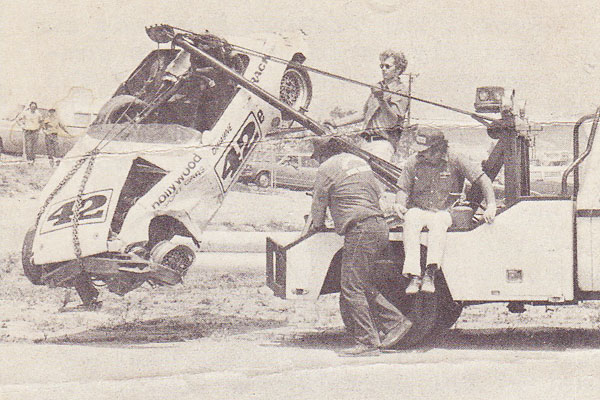
"This strong cross-braced roll bar probably saved Dwayne Anderson's life. Photo: Dan Fitzgerald"
On the very day Anderson was released from the hospital, Dave Staples informed him that the
sponsorship deal was over and that Staples expected full payment for the #42 racecar. Understandably,
since he didn't have enough cash on hand, Anderson stalled and worked to find an alternative repayment
option.
The first order of business was to procure a new racecar. (Makes sense to me!) Anderson purchased an
old MGB street car and stripped it down. He then transferred every undamaged part he could from the
wrecked #42 MGB to this new shell. Knowing he wasn't going to need any of the old #42's sheetmetal,
he could cut and grind away to extract the trademark Huffaker-built narrow-hoop roll cage completely
intact.

So that the brace from the top of the rollhoop rearward could be left alone, Anderson cut a slot
in the red MGB's rear deck, back almost to the trunk lid. (Photographer: Dwayne Anderson)
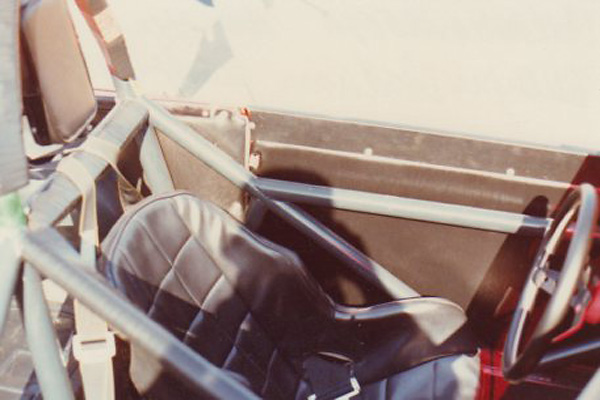
Period correct Huffaker seat and roll cage. In subsequent years, SCCA rule changes obliged racers
to supplement or upgrade door bracing. (Photographer: Dwayne Anderson)
The two most remarkable aspects of Anderson's project were the speed with which he worked and the
extent to which he was able to replicate Huffaker construction features. The Huffaker-built engine
and the MG four speed transmission were transferred between cars without any testing whatsoever.
Later model black rubber bumper skins were installed over specially made aluminum fabrications,
bolted to the chrome bumper bodyshell. Anderson had to make a new aluminum air dam and new oil
cooler ductwork from scratch.
Surprisingly, Anderson's goal was to have his red MGB all put together and ready to race by the
end of June. (He had to get an MGB on track if he was going to stay in the points race!) One mistake
kept the MGB from making that deadline: he tried to make it raceable without big enough fender
flares. After the delay of acquiring and fitting large Huffaker-style fiberglass flares, Anderson
had the car all together and painted red (with no graphics at all) by the July 4th weekend.
Unfortunately, Anderson was simply out of time. He was obliged to surrender the newly built
red MGB racecar to Dave Staples. Lee Mueller was there on the fateful day, having made his own
deal with Staples, and Anderson watched Mueller give the car a test drive. The car was race
ready, but one problem soon appeared. The gearbox had been internally damaged by the accident
at Riverside.
The red MGB was raced few times between when Lee Mueller first drove it on July 4th, 1977 through
the 1978 season. Mueller was actively campaigning a Triumph TR7, and indeed he drove his British Leyland
sponsored Huffaker TR7 to a second place finish in SCCA's D-Production class at the 1977 runoffs. Racing
the TR7 was also a top priority through 1978. Mueller's son John recalls that during the 1978 season his
father probably only drove the red MGB on four weekends, because that was the minimum number to qualify
for the runoffs.
Enjoying this article? Want to see more like it? Reader contributions help cover travel, web, and phone expenses.
We need your help! To contribute to our operating budget, please click here and follow the instructions.
(Suggested contribution is twenty bucks per year. Feel free to give more!)
As the 1978 runoffs approached, British Leyland and Huffaker Engineering reviewed their situation.
Through the previous several years they had entered a matching pair of MGBs, but this year Terry Visger
was out with a serious injury. Jon Woodner, best known for piloting smaller cars like Spridgets,
would drive the one remaining silver Huffaker MGB in the E-Production race. Lee Mueller would drive
a TR7 in the D-Production race. But there was an opportunity to improve the odds and increase British
Leyland's marketing exposure. Huffaker made arrangements to borrow the red MGB from Dave Staples for
Lee Mueller to drive under British Leyland and Huffaker decals!
The red MGB was already familiar to Huffaker Engineering and they knew it would be competitive.
John Mueller recalls that the red MGB was delivered to Huffaker Engineering in Sonoma.
According to Joe Huffaker Jr., all they had to do before taking it to Atlanta was their usual
torque-down, suspension adjustments, and application of sponsorship decals. The red
MGB traveled to Atlanta on the Huffaker team's transporter.
Lee Mueller qualified third and then drove the red #10 Huffaker MGB to a second place finish
at the 1978 SCCA runoffs. Jon Woodner qualified and finished in fourth place.
Anderson attended the runoffs that year as a spectator, proud of the car he'd assembled and of
his friends but obviously wishing he could have been in the red MGB's drivers seat. Perhaps he
might even have finished first. Driving a different MGB of his own design and construction,
Anderson finished seventh at the runoffs in 1979, fourth in 1980, and sixth in 1981.

1978 Champion Spark Plug Road Race of Champions at Road Atlanta. (Photographer: Clark W. Nicholls)
In the background, on the door of the truck, you can see a large photo of Terry Visger's silver MGB
in action. Visger wasn't at the runoffs in 1978 because he was recovering from injuries.
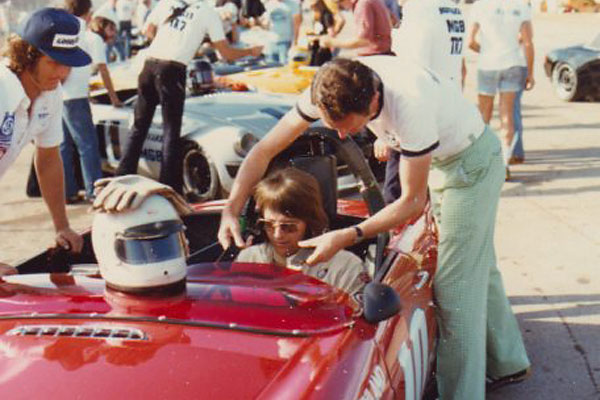
1978 SCCA Runoffs: Lee Mueller being strapped into the red Huffaker #10 MGB before the big race.
Jon Woodner is in the silver Huffaker #11 MGB behind Mueller. (Photographer: Dwayne Anderson)
After Huffaker...
Immediately after the 1978 runoffs, the red #10 Huffaker MGB was sold to the wife of Chris Doyle and
then presented to Chris as a gift. The Doyles purchased a trailer in Atlanta so they could bring their
new toy home from the track.
Chris Doyle returned to Atlanta for the 1979 SCCA runoffs and finished 6th in the red Huffaker MGB.
Doyle continued to campaign his MGB in SCCA events through the early 1980s.
Chris Doyle sold the red Huffaker MGB to Terry Stiles of Florida, who in turn leased the car to
Rick Gardella. Gardella drove the red MGB to a fourth place finish in SCCA's 1990 runoffs. After
Stiles, the red MGB passed through several more owners and drivers.
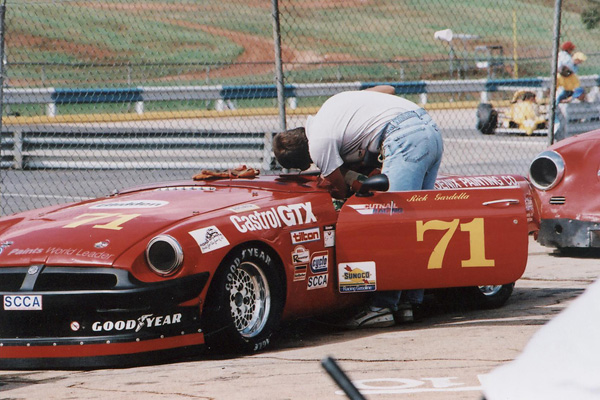
Rick Gardella at Road Atlanta, circa 1990. (Photographer: Rick Estes)
Gardella drove the red MGB to a fourth place finish in SCCA's 1990 runoffs.
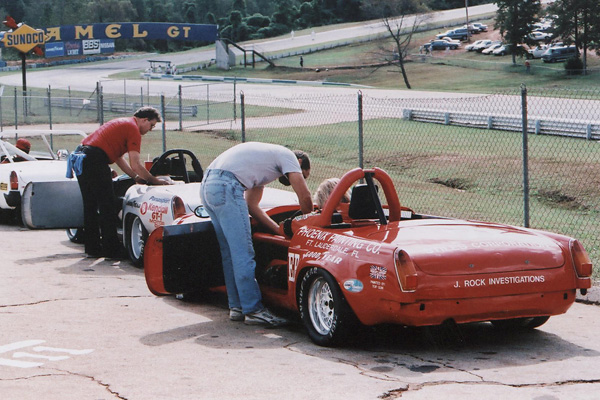
Jerry Rock was a private investigator and also a well regarded race mechanic. (Photographer: Rick Estes)
Notice that the original single-hoop roll cage was apparently still unmodified in this photo.
The slot and filler plate on the rear deck are visible, although the car has been repainted.
(The text under the British flag on the rear fender reads: "Painted By Top Gun".)
Many modifications were made to the car in the 1980s and 1990s to comply with changing SCCA rules
and to keep the MGB competitive. For example, Scorpion Racing was hired to remove the Huffaker style
roll structure and to replace it with a roll cage featuring a full width main hoop and stout side
intrusion protection bars.
Don Dickey is the red Huffaker MGB's current owner. Under Don's care and supervision it's seen a
two year rotisserie rebuild. Now it's ready for active service in vintage racing events. At
VSCDA's Road America Fall Festival the red Huffaker MGB was the top finishing MGB in Sunday's
"Sheldon Cup" feature race.
Features and Specifications
| Engine: | BMC B-Series (1845cc, 0.047" overbore), built by Tim Mountjoy.
Romac steel harmonic balancer / crankshaft pulley.
Pro-Craft cast aluminum intake manifold.
Dual S.U. HS8 (2") carburetors with machined aluminum shortie velocity stacks.
Mallory Unilite distributor.
Lucas Sport ignition coil.
Holley Annihilator 8mm spiral wound spark plug wires.
Wet sump lubrication system, with Huffaker style deep sump oil pan.
Wix oil filter.
Mocal 19-row oil cooler. |
| Cooling: | Ron Davis aluminum radiator. |
| Exhaust: | original Huffaker long center branch, flat collector 3-into-1 header.
Dynomax "Bullet" muffler. |
| Transmission: | MGB 4-speed straight cut, close ratio 4-speed transmission.
Fidanza aluminum flywheel.
Tilton 7.25" pressure plate and clutch.
Lockheed clutch master cylinder.
Girling slave cylinder. |
| Rear Axle: | modified early-model MGB "banjo" axle housing (with Salisbury style bearings/hubs).
Welded or limited slip differential, depending on the track.
Gear ratio selected (from 4.10 to 4.88:1), depending on the track. |
| Front Susp.: | 700# coil springs.
Dropped spindles, with steering connections modified to correct bump steer.
Armstrong lever action shock absorbers.
Adjustable 1" anti-sway bar mounted on aluminum pillow blocks.
Red polyurethane bushings. |
| Rear Susp.: | three-link rear suspension plus Panhard rod, utilizing (5-leaf) gullwing leaf springs from Huffaker Engineering.
(Gullwing in plan view, these springs were fitted when the car raced on much wider tires.)
Vintage Armstrong adjustable lever-type shock absorbers.
Custom adjustable anti-sway bar on aluminum pillow blocks. |
| Brakes: | (master) dual Girling master cylinders (5/8" front, 3/4" rear) with bias bar and custom remote reservoir. (front) stock MGB. (rear) stock MGB. |
| Wheels/Tires: | Revolution modular 14x7 aluminum wheels with Hoosier "Street T.D." P205/60D14 bias ply tires. |
| Electrical: | no charging system.
Braille battery.
Denso gear reduction starter. |
| Instruments: | (left to right)
Stewart Warner fuel pressure (1-15psi),
Stewart Warner water temperature (100-265F),
Westach dual EGT gauge (700-1700F),
Stewart Warner tachometer (0-8000rpm),
Stewart Warner oil pressure (5-100psi), and
Stewart Warner oil temperature (140-325F). |
| Fuel System: | Fuel Safe 12 gallon fuel cell.
Dual Carter fuel pumps.
Inertia switch.
Holley adjustable fuel pressure regulator.
Cartridge fuel filter. |
| Safety Eqmt.: | Kirkey aluminum drivers seat.
Simpson five point cam-lock safety harness.
Quick release steering wheel hub on a Grant GT ergonomic steering wheel.
Steering column is adjustable up-and-down.
FireBottle centralized fire suppression system.
Inertia cut-off switch mounted next to the electric fuel pumps.
|
| Bodywork: | rubber bumper skins (to give the appearance of late-model MGB "rubber bumpers").
Huffaker-style fiberglass fender flares.
Fiberglass trunk lid.
Transparent red low-profile windscreen. |
| Weight: | 1801 pounds. |
| Racing Class: | originally SCCA "E Production". Currently SVRA "3DP". |
Engine

BMC B-Series (1845cc, 0.047" overbore), originally built up by Tim Mountjoy.

Dual S.U. HS8 (2") carburetors with machined aluminum shortie velocity stacks.
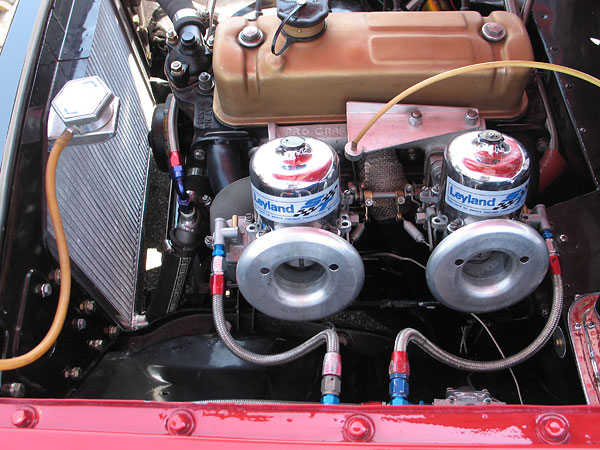
A rare Pro-Craft cast aluminum intake manifold supports those large bore carburetors.
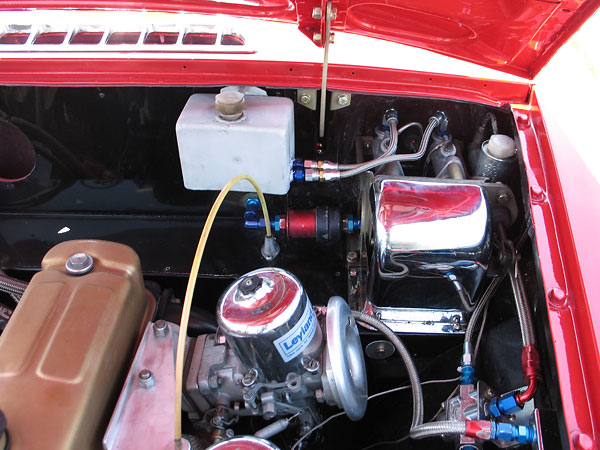
Dual Girling master cylinders (5/8" front, 3/4" rear) with bias bar and custom remote reservoir.
(The red cannister under the brake fluid reservoir is a fuel filter, not a fuel pressure gauge isolator.)
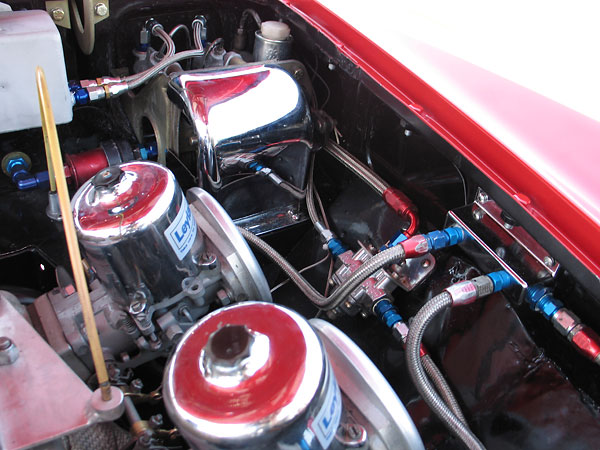
Holley adjustable fuel pressure regulator, and fuel distribution manifold.
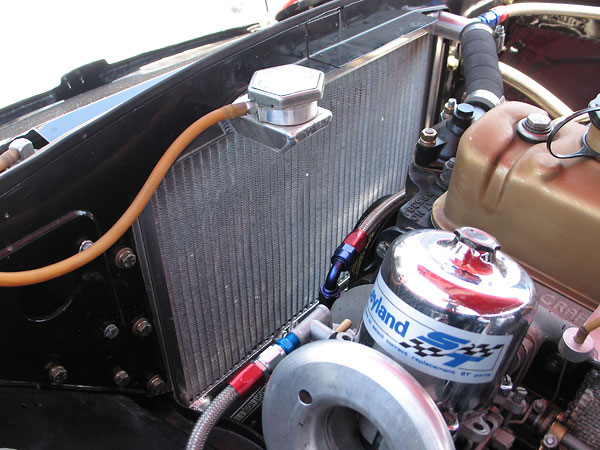
Ron Davis aluminum radiator.
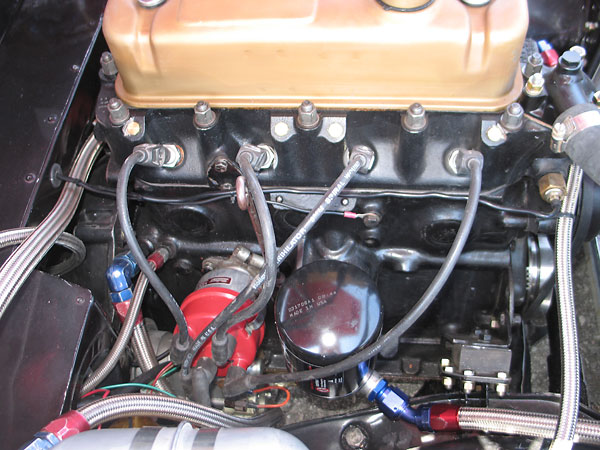
Mallory Unilite distributor. Holley Annihilator 8mm spiral wound spark plug wires.
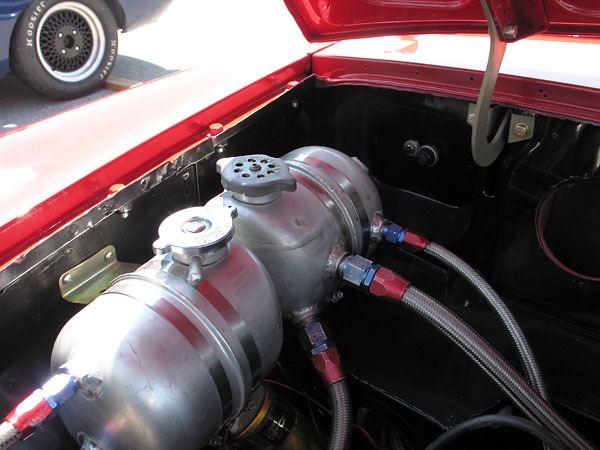
(background) Aluminum breather tank for venting fumes from the engine's crankcase.
(foreground) Aluminum header tank for the cooling system.
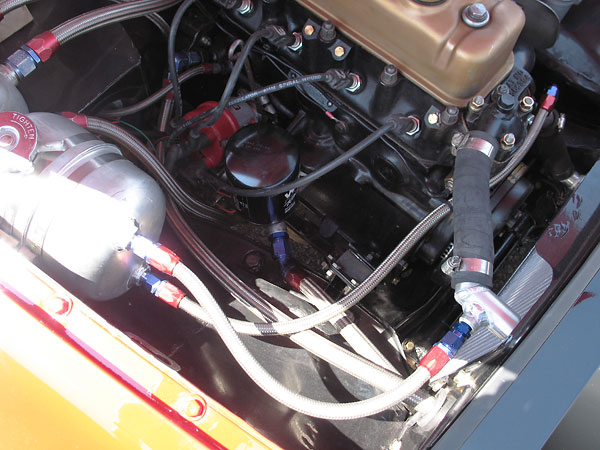
Hoses to and from the header tank are small to reduce flow, because any coolant
that passes through them is bypassing the radiator core.
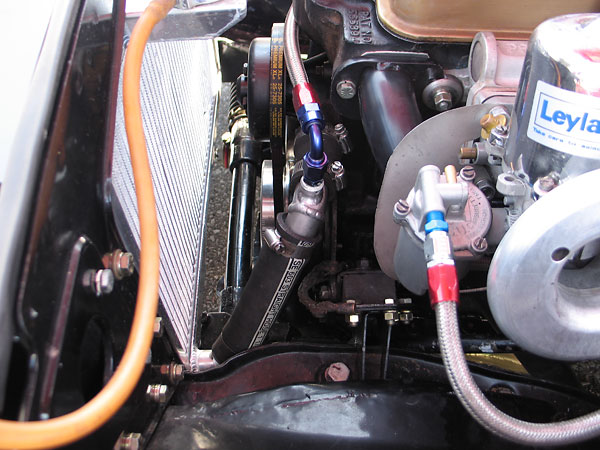
The radiator-mounted pressure cap is redundant with the pressure cap on the remote header tank.

Romac steel harmonic balancer / crankshaft pulley.

Simple ductwork improves the performance of this Mocal 19-row oil cooler.
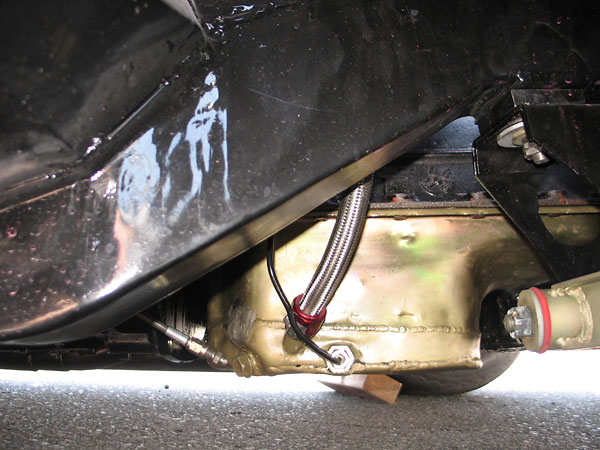
Huffaker-style deep sump oil pan. (Note: Huffaker didn't use pressurized oil accumulators in this era.)
Interestingly, in 1976 Dwayne Anderson created a prototype dry sump lubrication system for his
MGB and took it to Huffaker Engineering for them to test on their dynomometer. They learned that
the system increased horsepower by at least 3hp across the whole rpm range. Anderson used his
dry sump system when racing his own cars, but he didn't transfer it onto the red MGB.
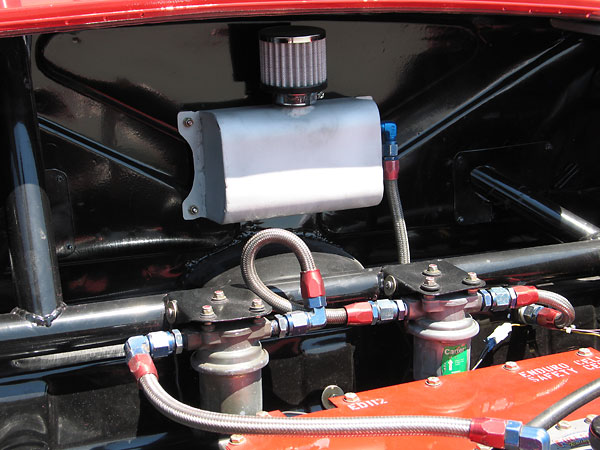
Very generously sized breather tank for the rear axle. (This is a newer addition to the car.)
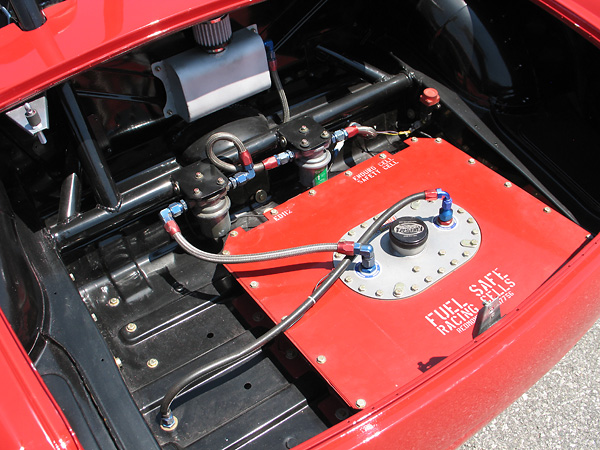
Dual Carter electric fuel pumps, with an inertia cut-off switch for safety. The plumbing seen here is
different from what Huffaker or Anderson would have done. Anderson's method was to have one pump
feeding into a surge can within the main fuel cell. The surge can would then stay full regardless of overall
fuel level or g-forces. The second Carter fuel pump drew its supply from the bottom of the surge can.
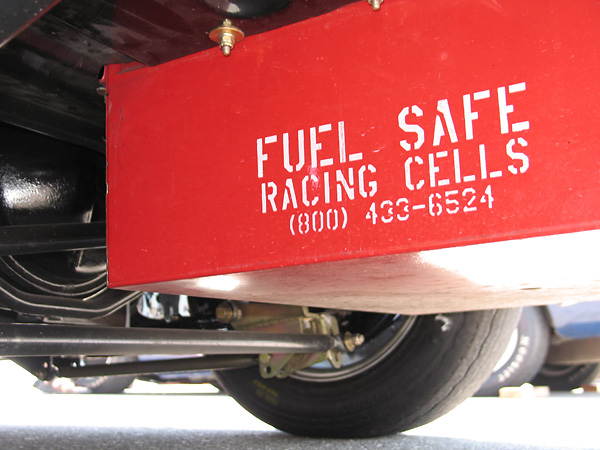
Fuel Safe 12 gallon fuel cell.
Front Suspension
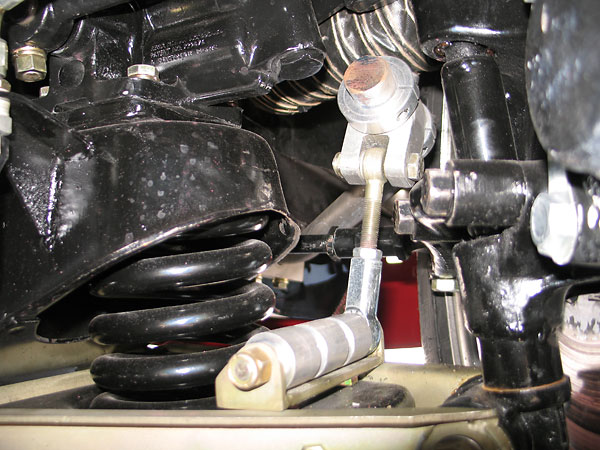
A low stance is critical to optimized handling, as is the correct spring rate and the elimination
of bump steer. These stiff (700 #/inch) coil springs are shorter in length than stock springs.
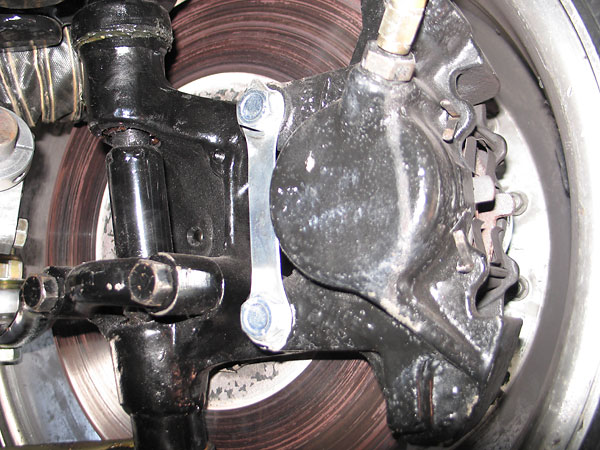
When we photographed Don's MGB, dropped spindles were installed. In other words, the original cast iron
uprights had been cut and rewelded in order to lower ride height an additional inch or so. (Don reports
that these uprights have subesquently been removed from his MGB. Huffaker didn't use dropped spindles.)
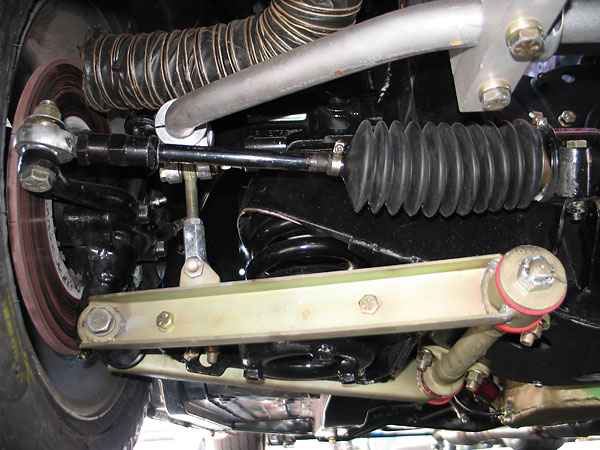
Regardless of how the front ride height is lowered, it's very important to finish the job by checking
and correcting bump steer. Bump steer is the tendency of a wheel to toe-in or toe-out as the suspension
travels vertically. Don can adjust bump steer by shimming the Heim joint on the steering link up or down.
The brake cooling duct, which draws air from the headlamp area, isn't something Anderson or Huffaker
recall fitting on their MGB's for sprint races. These ducts serve endurance racers well. Huffaker did,
however, sometimes use a left-side mounted headlamp duct to supply cool air to the carburetors.
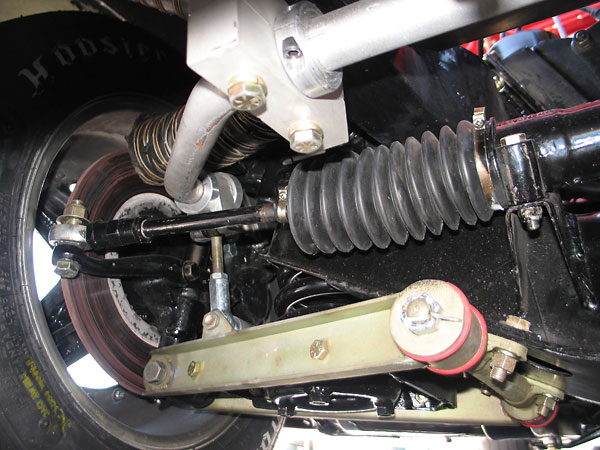
Adjustable 1" anti-sway bar mounted on aluminum pillow blocks. Red polyurethane A-arm bushings.
Rear Suspension
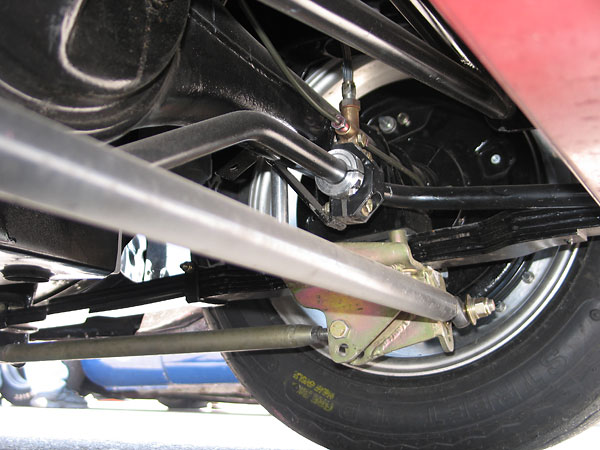
This is a "three link" suspension, plus a Panhard rod, but with leafsprings instead of the
coil springs most people associate with a three link. Huffaker put steel "distance tubes" on
the u-bolts so the axle can float a bit relative to the springs. The three forward links and the
Panhard rod together locate the axle far more precisely and predictably than leafsprings alone.
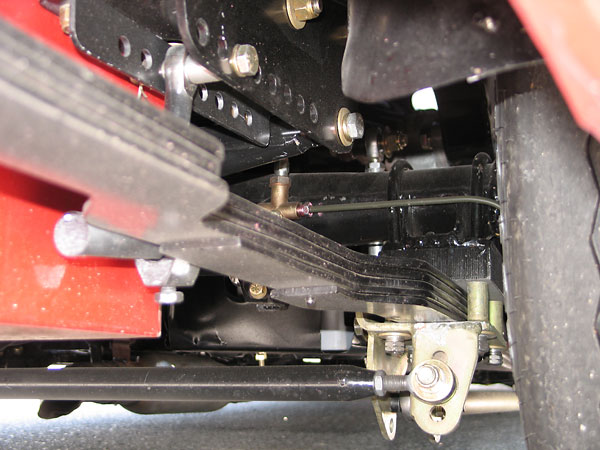
It's been many years since Huffaker Engineering has offered their distinctive "offset" leafsprings.
These were made to accomodate the wide Goodyear racing slicks of the red Huffaker MGB's era.
Even though narrower tires are installed now, it's neat that offset springs remain in place.
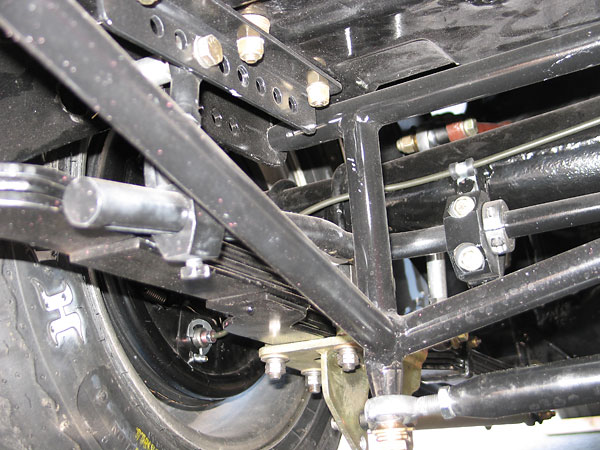
Custom adjustable anti-sway bar on aluminum pillow blocks, mounted where it's easily accessible.
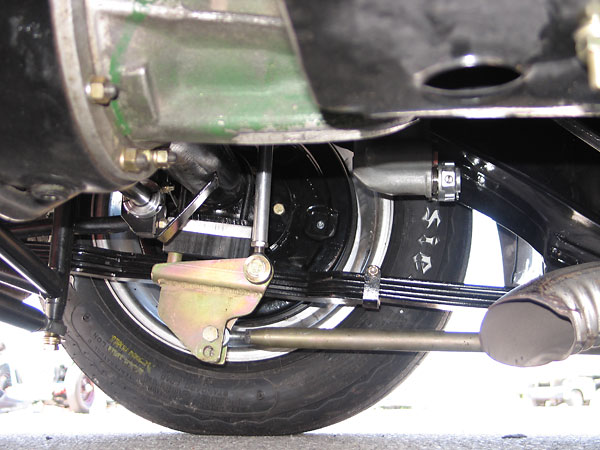
Of the three horizontal links (a.k.a. radius rods) that comprise a three link rear suspension,
two are usually particularly easy to see. They typically mount underneath and basically parallel
to where leaf springs are or would go. Typically, both front and rear mounting points are designed
for height adjustability because the angle of the bar affects roll steer and anti-squat behavior.
The Armstrong adjustable-valve lever shocks seen here are a valuable and highly regarded rarity
(however, they certainly weren't on this car when Anderson built it or when Huffaker raced it.)
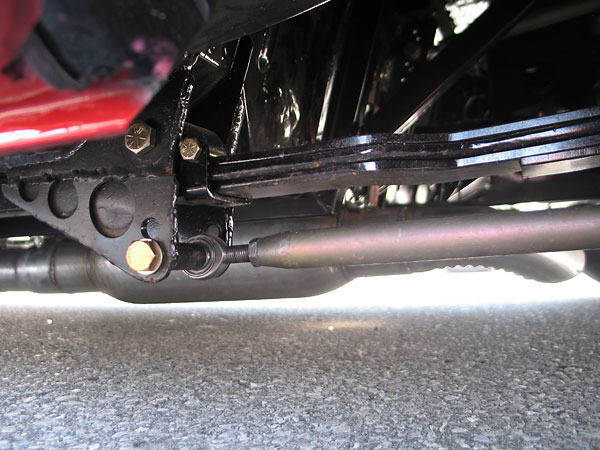
The MGB chassis features elegant unibody construction (as opposed to "body-on-frame" construction),
so suspension attachment points require extra thought. These mounts spread loads over a large area.
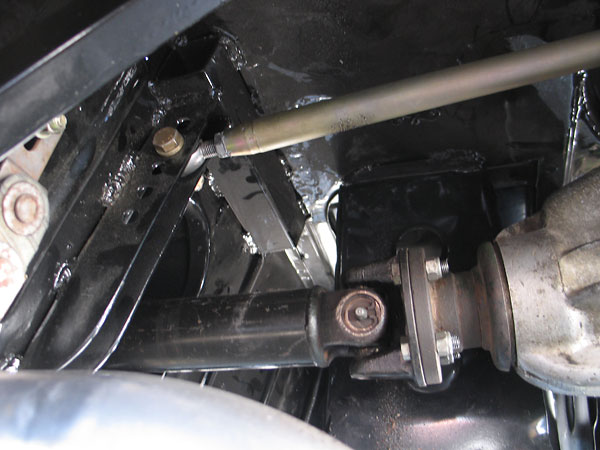
The third link of a three link suspension is typically located above the pinion of the rear axle.
It's adjustable, because the mounting angle of this radius rod also affects the car's handling.
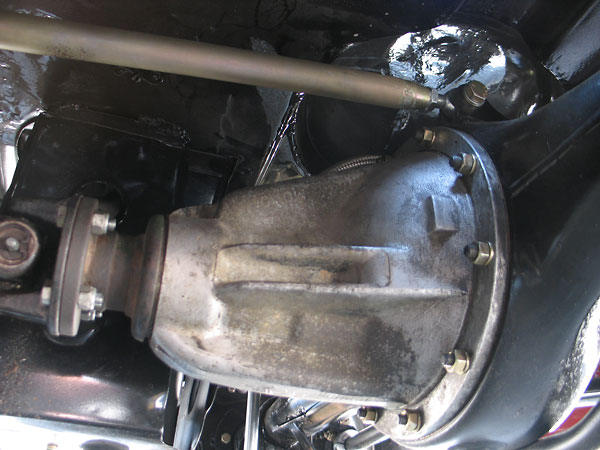
Ideally, this third link would be on the body's longitudinal centerline, but for practical reasons
we often see third links connected to one side or the other of the driveshaft tunnel.
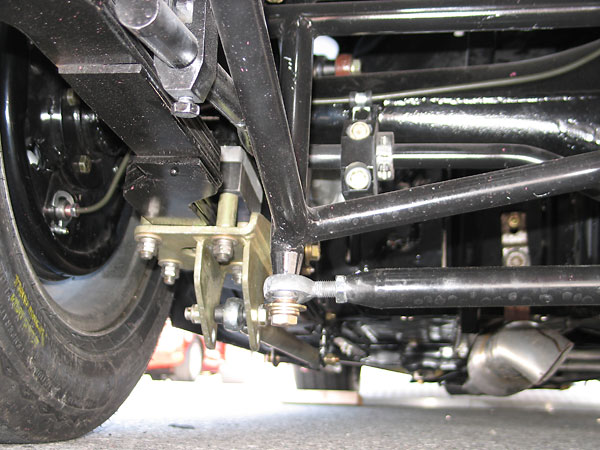
Finally, a Panhard rod restrains the body from shifting side-to-side relative to the tires as the
car corners. Huffaker deliberately mounted their Panhard rods rather low. This decision shifted
the rear suspension's roll center somewhat lower than commonly seen on MGB racecars.
Roll Structure
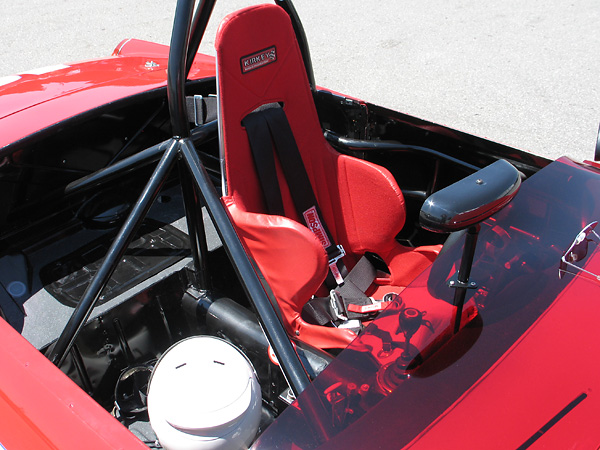
One unusual feature of original Huffaker MGB roll cages was that 1.75" tubing was used for the main
hoop and rearward brace, combined with 1.5" tubing for all the diagonal support tubes.
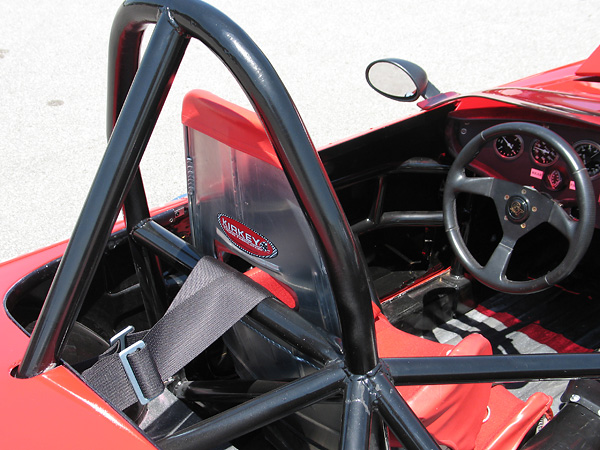
Of course this Kirkey aluminum racing seat is a concession to modern safety standards. The period
correct seat would have been a low back fiberglass bucket, used with a roll hoop mounted headrest.
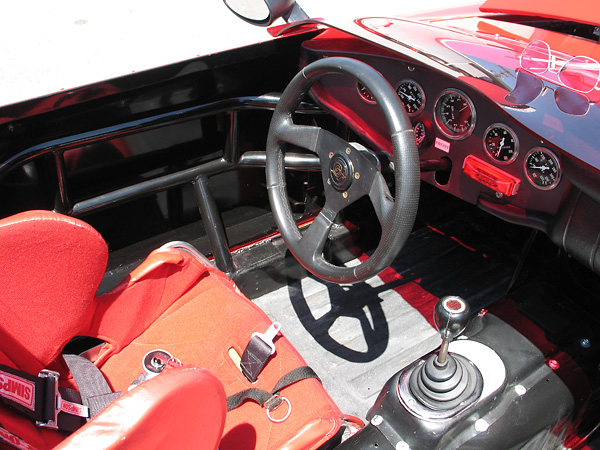
Side intrusion bars that extend into the door cavity were added for SCCA racing in the 1980s.
When restoring the red Huffaker MGB, Don saw no reason to remove this valuable safety feature.
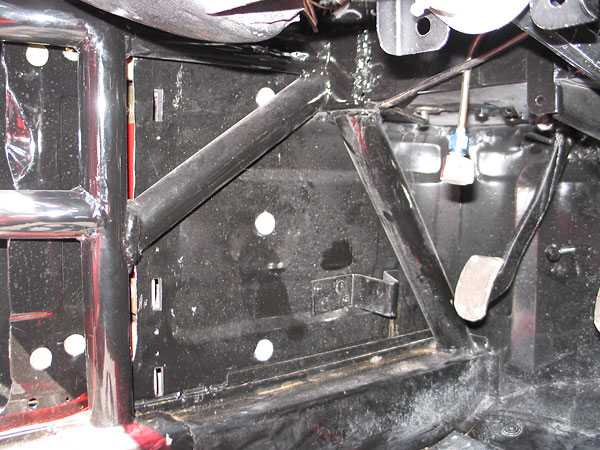
The roll cage extends further forward to protect the footbox area.

Roll structure in the trunk area.
Enjoying this article? www.BritishRaceCar.com is partially funded through generous support from readers like you!
To contribute to our operating budget, please click here and follow the instructions.
(Suggested contribution is twenty bucks per year. Feel free to give more!)
Interior

"Abingdon Pillow" style dashboards (as shown here) were used by MG from 1968 through 1971.
They were designed to meet a very conservative interpretation of U.S. federal safety laws.
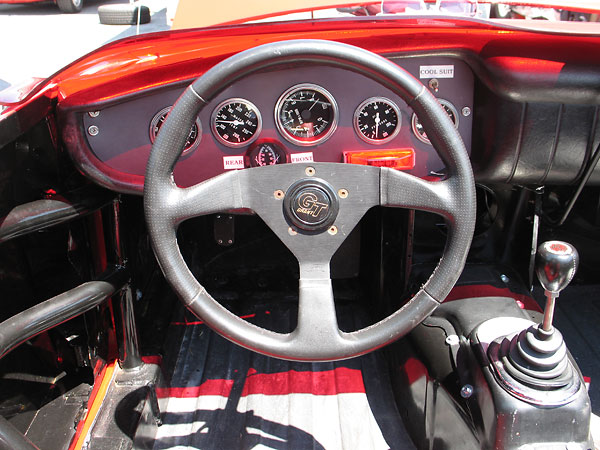
Grant GT ergonomic steering wheel.
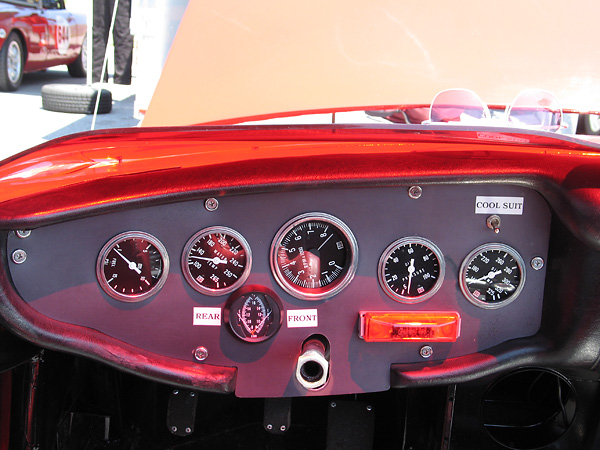
Stewart Warner fuel pressure (1-15psi), water temperature (100-265F), tachometer (0-8000rpm),
oil pressure (5-100psi), and oil temperature (140-325F) gauges. Westach dual EGT gauge (700-1700F).
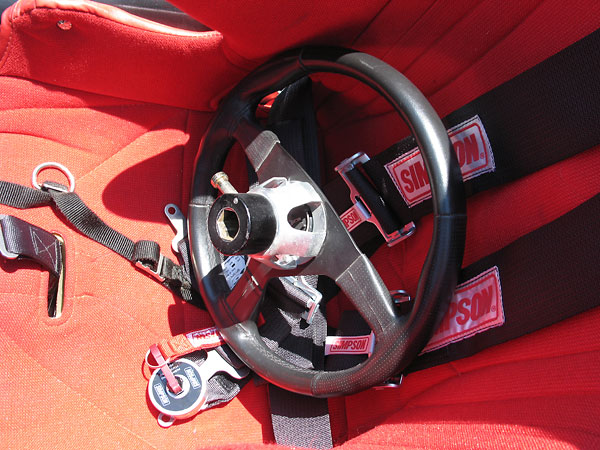
Quick release steering wheel hub.
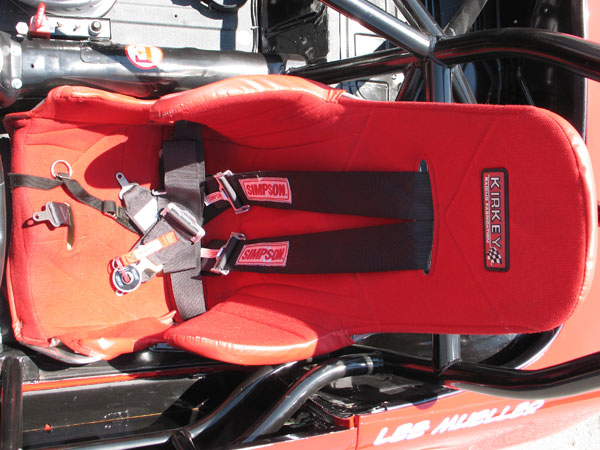
Simpson five point cam-lock safety harness.

Enlarged throttle pedal surface, altered pedal spacing... and a dead pedal has been installed.
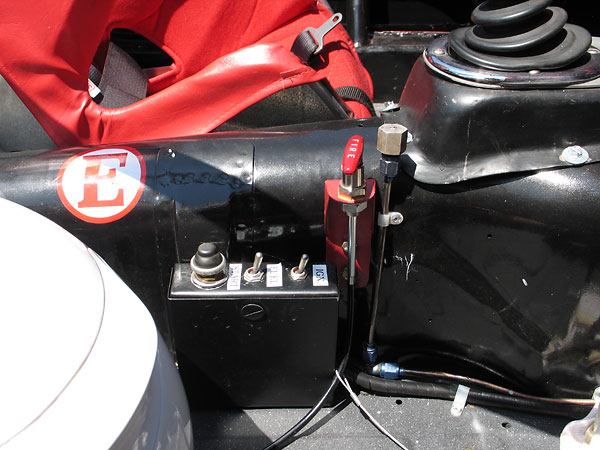
Huffaker preferred to relocate key switches from the dashboard to a remote enclosure.
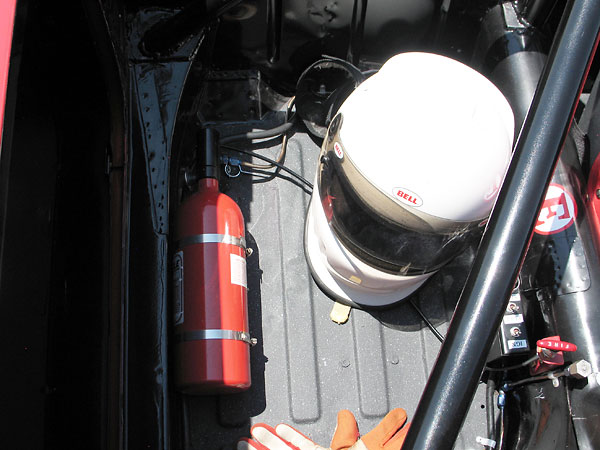
FireBottle centralized fire suppression system.
Exterior
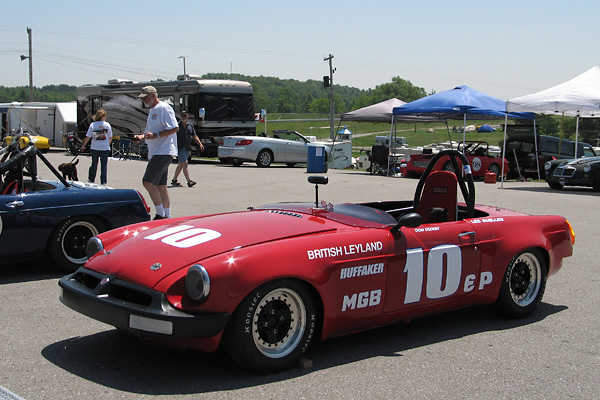
Lee Mueller drove this red Huffaker MGB to a second place finish at the 1978 SCCA run-offs.
Rick Gardella nearly repeated twelve years later. He finished 4th with it at the 1990 run-offs.
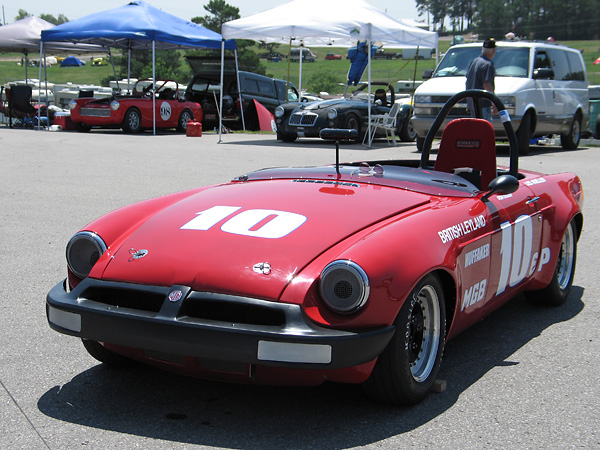
The rearview mirror was originally mounted behind the windscreen.
(You're not supposed to look at it while driving, right?)
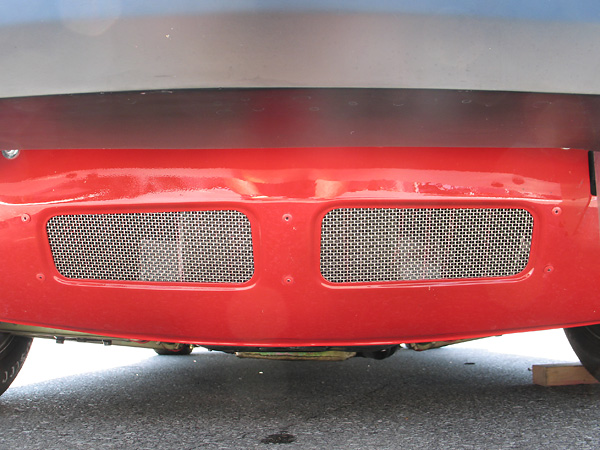
Huffaker created their own distinctive air dams to divert airflow around and over the front of their cars.
Why? Less aerodynamic drag plus reduced air pressure under the cars to achieve a modest measure
of aerodynamic downforce. Air dams are however prohibited in the class Don currently races in, so a
1973-1974.5 front valance has been installed instead. (These years had holes for oil coolers.)
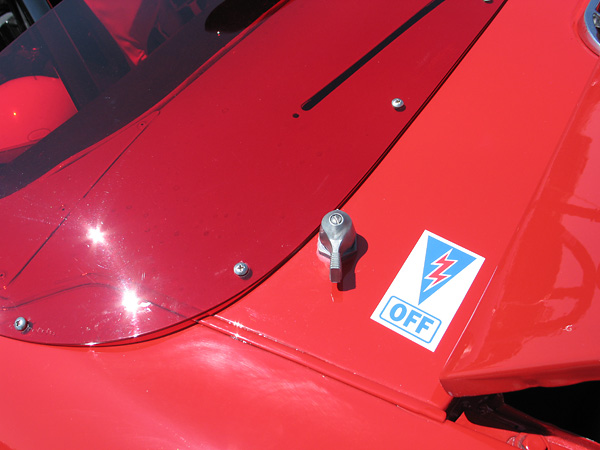
Joseph Pollak battery disconnect switch.
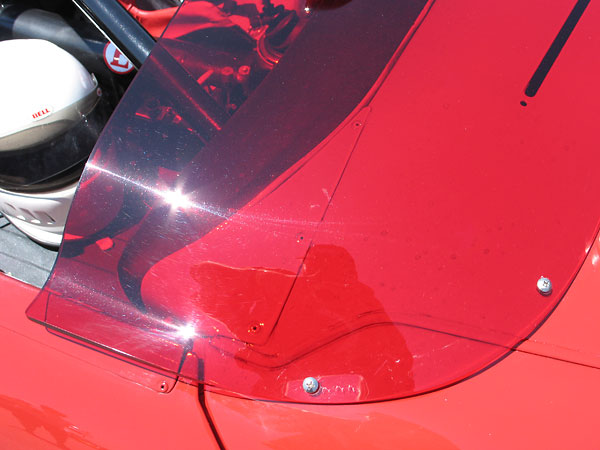
One of the distinctive original features of this MGB is its transparent red low-profile windscreen.
Note: Huffaker still has the molds to make replacements.
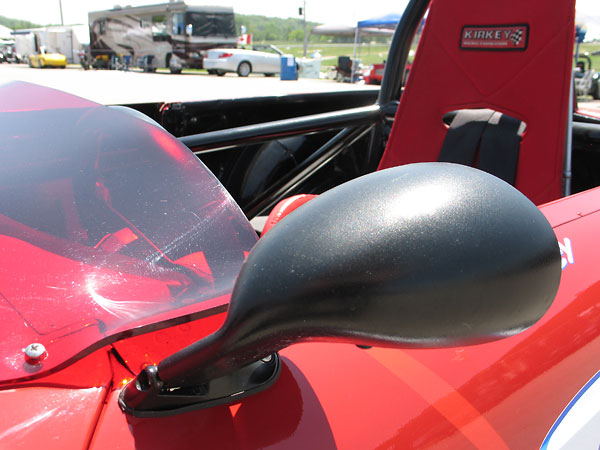
This SPA Design mirror is a different design from the Vitaloni "Sebring" model that Huffaker preferred
back in the day. The Sebring model mounted flat to horizontal tops of custom sheetmetal brackets.
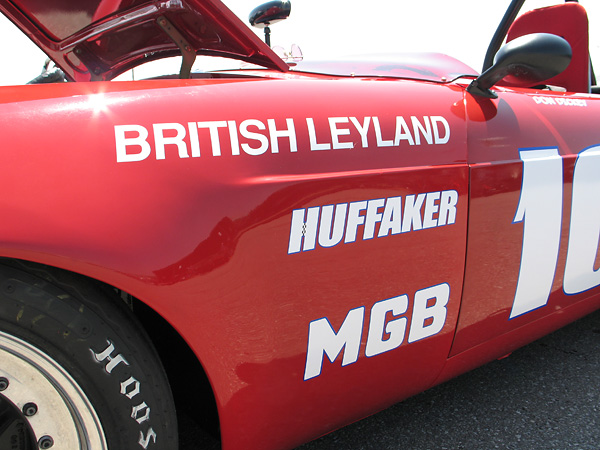
British Leyland sponsored Huffaker Engineering of California.
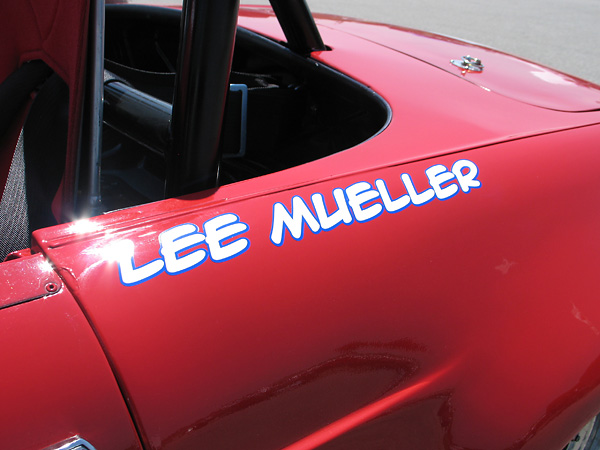
Lee Mueller: 4-time SCCA National Champion ('69 FP-class Triumph Spitfire, '73 DP-class Jensen Healey,
'74 DP-class Jensen Healey, '79 DP-class Triumph TR7), winner of the 12 hours of Sebring ('81 GTU-class
Mazda RX-7), and 3-time winner of the 24 hours of Daytona ('82 GTU-class Mazda RX-7, '83 GTU-class
Mazda RX-7, '86 GTO-class Ford Mustang). Mueller also won the '81 IMSA GTU Driver Championship.

British Leyland stipulated that Huffaker fit then-current "rubber bumpers". (MG started installing
rubber bumpers mid-year in 1974.) Huffaker installed the rubber skins over custom lightweight structures.
When we photographed Don's MGB at Mosport, the rear bumper had been temporarily removed.
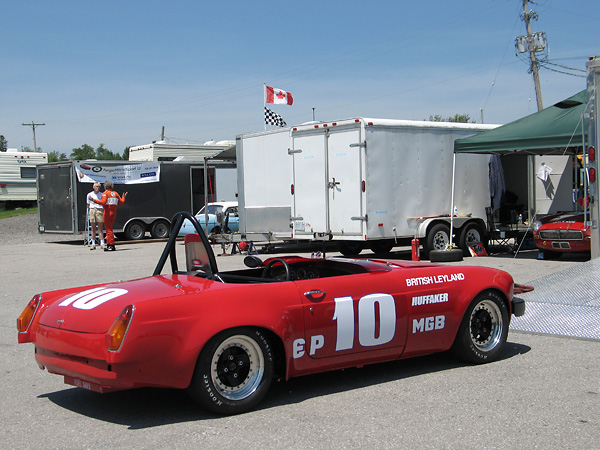
With the rubber bumper removed, MGB enthusiasts will easily spot that this car was built from
an earlier "chrome bumper" bodyshell; immediately below the taillights, the car's body comes
outward to match the pointed shape of the chrome taillamp bezel. The doors feature pushbutton
exterior handles. MG switched from pull-handles to pushbutton handles around April 1965. The
later design has a safer latch and a reinforcing bar which provide slightly more impact protection.
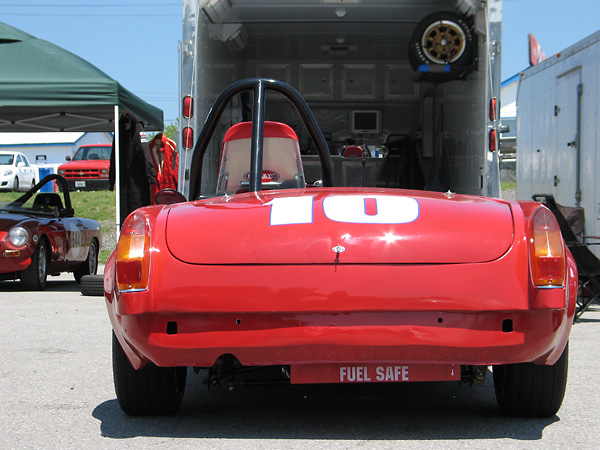
The production fuel filler has been shaved off.
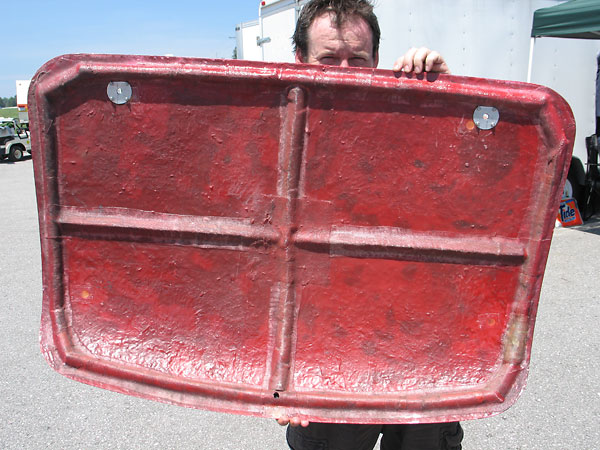
Custom fiberglass trunk lid. (It's a nifty part, of newer origin.)

Revolution three-piece modular 14x7 aluminum wheels.
(As Anderson recalls, black BBS wheels were on the car through 1978.)

Hoosier "Street T.D." P205/60D14 bias ply tires.
BritishRaceCar.com is grateful to the following gentlemen for granting interviews necessary for the
completion of this article: Dwayne Anderson, Don Dickey, Joe Huffaker Jr. of Huffaker Engineering,
John Mueller of Muellerized Inc., Terry Visger of Visger Precision Inc., and Hap Waldrop of Acme Speed Shop.
Except for vintage photos otherwise credited in their captions, all photos shown here are from June 2010
when we viewed the car at VARAC's 31st Intl. Vintage Racing Festival at Mosport Motorsports Park,
in Ontario Canada. Photos by Curtis Jacobson for BritishRaceCar.com, copyright 2010. All rights reserved.
| If you liked this article, you'll probably also enjoy these: | |||||
 |
Mike Adams 1963 MGB |
 |
John Targett 1964 MGB |
 |
Eddie Beal 1978 MGB |
| You're invited to discuss anything you've seen here on The British Racecar Motorsports Forum! | |||||
Notice: all the articles and almost all the photos on BritishRacecar.com are by Curtis Jacobson.
(Photos that aren't by Curtis are explicitly credited.) Reproduction without prior written permission is prohibited.
Contact us to purchase images or reproduction permission. Higher resolution images are optionally available.


